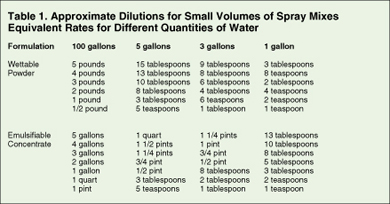It seems the time right after making first cutting hay is always a time for me to address some of those unwanted weed issues — not in the hay fields, but in the fence rows, around buildings and in pastures.
Hand-held and spot sprayers are inexpensive tools often used to apply pesticides on small areas. Whether it’s insecticides or fungicides in a garden or small orchard, or herbicides in a fence row or pasture field, pesticide applications using small capacity sprayers can protect the landowner’s crop from insects or diseases and reduce weed pressure.
Doing the math. Products we use in these sprayers have labels listing the rate of product to apply, but often is can be confusing when calculating an amount for one gallon of mixture compared to label language listed for acre rates or for large amounts of water.
Table 1. is a chart taken from one of our OSU Extension publications that may help you calculate small amounts when larger rates are given.
Other helpful formulas and bits of information are listed here to help you mix the correct amount for small scale equipment.
Dry Formulation Measurement Equivalent
1 pound = 16 ounces = 454 grams
1 ounce = 28.4 grams
1 ounce per square foot = 2,722.5 pounds per acre
1 ounce per 100 square feet = 27.2 pounds per acre
To convert pounds per acre to pounds per 1,000 square feet, divide pounds per acre by 43.56.
Liquid Formulation Measurement Equivalent
1 gallon = 4 quart = 8 pints = 16 cups = 128 fluid ounces = 3785 milliliters
1 cup = 8 fluid ounces
1 fluid ounce = 2 tablespoons = 29.6 milliliters
1 milliliter = 1cc (Calibrated syringes work great for small liquid amounts)
1 level tablespoon = 3 level teaspoons
1 teaspoon = 5 milliliter
1 tablespoon = 15 milliliter
To convert gallons per acre (GPA) to gallons per 1,000 square feet, multiply GPA x 0.023 = Gal. per 1,000 square feet.
Example: If a product lists a liquid application rate as 1 quart mixed in 100 gallon of water the calculation for one gallon would be as follows: 32 oz. (1 quart) / 100 = 0.32 fluid ounces.
While it would be very hard to correctly measure 0.32 fluid ounces in a measuring cup, if we multiply by 29.6 milliliters (number of ml. per fluid ounce), we can easily measure 9.5 ml or 9.5 cc in a calibrated syringe.
Make sure you calibrate. Remember that hand-held, backpack, and spot sprayers can and should be calibrated so accurate rates of pesticides are applied. Too much pesticide applied can be expensive and environmentally harmful, while too little pesticide applied may result in unsatisfactory results.
OSU Factsheet F-21, Calibration Of Hand Sprayers For Herbicide Application, provides information needed to calibrate these type sprayers.
Care should always be taken when measuring pesticide amounts, but it’s extremely important in small sprayers because errors will be magnified at small volumes.
(The author is an OSU Extension Agriculture and Natural Resources Extension Educator in Monroe County, Ohio. Questions or comments can be sent in care of Farm and Dairy, P.O. Box 38, Salem OH 44460.)













